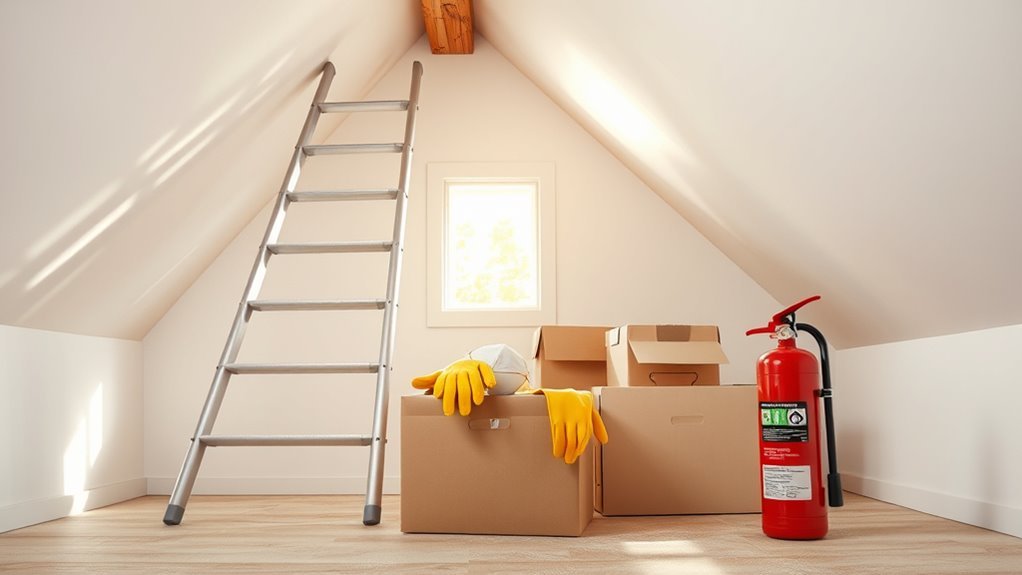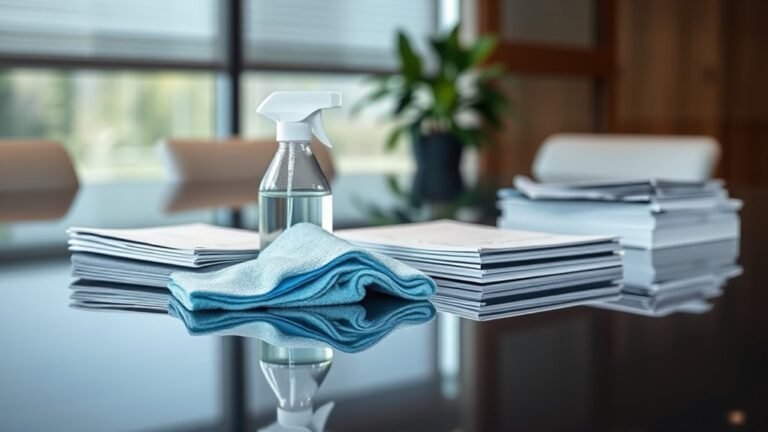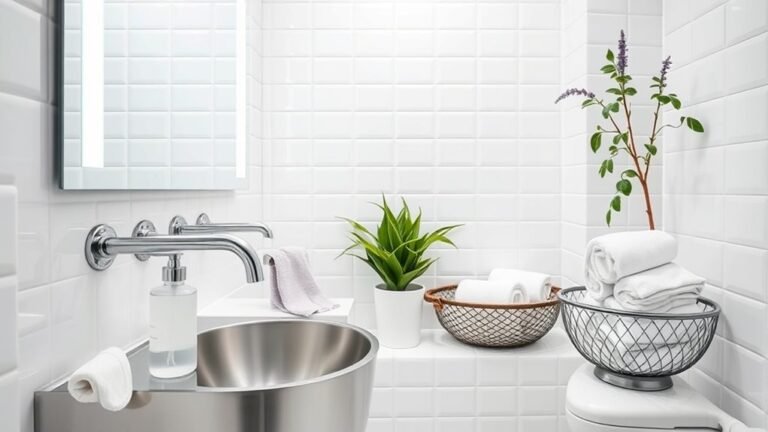How to Clean Attic in Office Spaces
To clean your office attic, first assess its condition for structural issues, pests, or mold. Gather supplies like gloves, dust masks, a vacuum with HEPA filter, and sturdy bags. Prioritize safety by ensuring proper ventilation and wearing protective gear. Remove debris carefully, sort items, then dust and vacuum all surfaces thoroughly. Treat any mold or pest problems promptly, and improve ventilation for long-term health. Keeping this space maintained will streamline the process and prevent costly problems down the line.
Assessing the Condition of the Office Attic

How do you begin evaluating the condition of your office attic? First, verify you have sturdy footwear and a reliable light source before entering. Carefully inspect the attic insulation—check for dampness, gaps, or damage that could impact energy efficiency. Uneven or compromised insulation not only wastes resources but limits your freedom to control the office environment. Next, assess existing storage solutions; look for clutter, unstable shelving, or improperly stored items posing hazards. Note any signs of pests or structural issues like leaks or sagging beams, which could compromise safety. Document everything clearly to plan necessary repairs or upgrades. By systematically evaluating these aspects, you maintain a safe, efficient attic space that supports both practical storage and your desire for a well-organized, free workspace.
Gathering Necessary Cleaning Supplies and Equipment
Before you start cleaning, make sure you have the essential tools like a broom, vacuum with a HEPA filter, and sturdy trash bags. Don’t forget protective gear such as gloves, a dust mask, and safety goggles to guard against dust and debris. Having the right equipment ready will keep the process safe and efficient. Additionally, ensure proper lighting and ventilation to maintain safety and effectiveness during attic cleaning, as highlighted in Safe Dust and Debris Removal Techniques.
Essential Cleaning Tools
Gathering at least five vital cleaning tools will make tackling your office attic much safer and more efficient. Start with a sturdy broom and dustpan to sweep away dust and debris. A reliable vacuum cleaner with a HEPA filter is important for removing fine particles without spreading them around. Include microfiber cloths for wiping surfaces and trapping dust effectively. A multipurpose cleaner spray will help you tackle various stains and grime. Finally, a durable trash bag or container is necessary for collecting and disposing of waste. Before you begin, consult a cleaning checklist to confirm you’ve gathered all essential supplies, minimizing interruptions. Being well-prepared not only streamlines your work but also safeguards your health, giving you the freedom to focus on the task without unnecessary risks.
Protective Gear Requirements
Once you have your cleaning tools ready, it’s important to equip yourself with the right protective gear to stay safe while working in the attic. Personal protective equipment (PPE) like gloves, safety goggles, and a respirator mask are essential to guard against dust, insulation fibers, and potential mold. A hard hat protects you from low beams or unexpected bumps, while sturdy, non-slip footwear guarantees stable footing on uneven surfaces. Always follow local safety regulations to avoid hazards and potential fines. Wearing long sleeves and pants also helps minimize skin exposure. By adhering to these protective gear requirements, you maintain your freedom to work effectively without risking injury or health problems. Prioritize safety—it’s the foundation for a successful attic cleaning in any office space.
Ensuring Safety Measures Before Starting

Three essential safety measures you need to take before cleaning an office attic include checking the structural integrity, ensuring proper ventilation, and wearing protective gear. Following safety protocols minimizes risks like fall hazards and exposure to harmful dust. Double-check the attic floor for weak spots and confirm the ventilation system is working to avoid suffocation or overheating. Always gear up with gloves, masks, and sturdy footwear.
| Safety Measure | Reason | Action Needed |
|---|---|---|
| Structural Integrity | Prevents falls and collapses | Inspect beams and flooring |
| Ventilation | Avoids respiratory issues | Open vents or use fans |
| Protective Gear | Shields from dust and debris | Wear gloves, masks, footwear |
| Lighting | Improves visibility | Use portable lights |
| Clear Pathways | Reduces trip risks | Remove obstacles beforehand |
Stick to these steps for a safe, efficient attic cleaning.
Removing Debris and Unwanted Items
Before you start removing debris and unwanted items from the attic, make certain you have a clear plan for sorting and disposing of materials safely. Begin by categorizing everything into debris disposal, unwanted item donation, and items to keep. Use sturdy bags or bins for debris disposal to avoid spills and guarantee proper handling of any hazardous materials. For unwanted item donation, check local charities or organizations that accept office supplies and furniture, giving you the freedom to declutter responsibly. Wear gloves and a mask to protect yourself from dust and sharp objects during removal. Keep pathways clear to avoid trips or falls. By staying organized and safety-focused, you’ll efficiently clear the attic, creating a clean, functional space without unnecessary risk or waste. Setting up a designated sorting area with clear labels helps streamline the process and maintain organized workspace efficiency.
Dusting and Vacuuming Surfaces Thoroughly

Clearing out debris and unwanted items is just the start of restoring your attic’s condition. Next, focus on dusting and vacuuming surfaces thoroughly to maintain a clean, healthy environment. Use a vacuum with a HEPA filter to trap fine particles, ensuring effective dust control without releasing allergens back into the air. Wipe down all surfaces with a damp cloth to catch remaining dust, paying close attention to corners, beams, and vents. Regular surface maintenance reduces airborne dust, improving air quality and protecting office equipment stored in the attic. Always wear a dust mask and gloves for safety. By diligently controlling dust and maintaining surfaces, you’ll create a safer, freer workspace that supports productivity and wellbeing. To prevent buildup and maintain cleanliness, establish a regular cleaning schedule that includes dusting and vacuuming tasks.
Inspecting for Signs of Mold and Pest Infestation
You’ll want to carefully check for mold spots, which often appear as discoloration or musty stains on wood and insulation. Keep an eye out for pest signs like droppings, nests, or gnaw marks around beams and stored materials. Catching these early helps prevent health risks and costly repairs.
Identifying Mold Indicators
How can you tell if mold or pests have taken up residence in your office attic? Identifying mold indicators early helps you maintain a safe, clean environment and reinforces mold prevention efforts. Look for discoloration on walls, musty odors, or visible patches of common mold types like black, green, or white mold. Use the table below to guide your inspection:
| Mold Type | Appearance | Common Location |
|---|---|---|
| Black Mold | Dark green/black spots | Damp wood, insulation |
| White Mold | Powdery white patches | Drywall, attic beams |
| Green Mold | Green fuzzy growth | Moist surfaces |
Always wear protective gear to avoid exposure, and address moisture sources promptly to prevent mold from spreading.
Detecting Pest Activity
Alongside mold, pests can silently compromise your office attic’s cleanliness and safety. To protect this space, you need to master pest identification techniques. Start by looking for droppings, gnaw marks, nests, or unusual odors. Check corners, insulation, and wood beams carefully. Use a flashlight to spot any movement or signs of insects and rodents. These indicators help you act before infestations grow. Implement pest prevention strategies such as sealing cracks, improving ventilation, and removing food sources. Keep the attic dry, since moisture attracts both mold and pests. Regular inspections are essential to maintain a pest-free environment, ensuring your office attic remains a safe, clean area. Taking these precise steps gives you control and freedom from costly damages.
Treating Mold and Pest Issues Effectively
Since mold and pests can compromise both structural integrity and indoor air quality, addressing these issues swiftly is crucial when cleaning your office attic. Start with thorough mold treatment: wear protective gear, remove affected materials if possible, and apply EPA-approved antifungal solutions to prevent spore spread. Dry the area completely to discourage regrowth. For pest control, identify the type of pests first—rodents, insects, or others. Use targeted baits, traps, or insecticides designed for attic environments, always following label instructions carefully. Seal entry points to stop future invasions. Regularly monitor treated zones to guarantee the problem’s resolved. By tackling mold and pests decisively, you maintain a safer, healthier workspace, giving you the freedom to focus on your core business without worrying about hidden attic hazards. Proper airflow and exhaust fans significantly reduce moisture buildup, which is essential for preventing mold recurrence in attic spaces.
Improving Attic Ventilation and Airflow
Although it might seem minor, improving attic ventilation and airflow is essential for maintaining a safe and efficient office environment. You’ll want to assess your current ventilation systems to guarantee they’re functioning properly—blocked vents or damaged fans can reduce airflow, leading to moisture buildup and overheating. Consider installing ridge vents or soffit vents to promote continuous airflow, which helps regulate temperature and prevents mold growth. Upgrading to energy-efficient fans can also enhance ventilation systems without driving up energy costs. When making airflow improvements, prioritize safety by turning off electrical systems before adjustments and using appropriate protective gear. By optimizing your attic’s airflow, you not only protect structural integrity but also contribute to a healthier workspace where everyone can enjoy freedom from stuffy, hazardous conditions. Managing moisture buildup effectively is crucial to preventing mold and mildew in tropical climates.
Scheduling Regular Attic Maintenance and Cleaning
When you want to keep your attic in top condition, scheduling regular maintenance and cleaning is key. Establish a cleaning schedule based on your office’s usage and environmental factors — biannual checks often work well. During attic maintenance, inspect for leaks, pests, and insulation issues; these can compromise your workspace’s safety and comfort. Always wear protective gear and guarantee proper ventilation while working. Set reminders to clear debris, dust, and any stored clutter that can attract rodents or mold. Document each maintenance session to track recurring problems and improvements. By staying consistent, you’ll avoid costly repairs and keep your attic functioning efficiently, giving you the freedom to focus on your office’s productivity without worrying about hidden attic problems. Use a flashlight to examine dark corners thoroughly to spot potential issues early, such as structural damage.
Frequently Asked Questions
Can Cleaning the Attic Improve Overall Office Air Quality?
Yes, cleaning the attic can greatly improve your office’s air quality. When you reduce dust accumulation up there, you limit airborne pollutants that often circulate throughout the building. By tackling this area safely and thoroughly, you prevent allergens and irritants from affecting your workspace. Keeping the attic clean helps you breathe easier, promotes a healthier environment, and gives you more freedom to focus without distractions from poor air quality.
How Often Should Professional Attic Inspections Be Conducted?
Wondering when you should schedule that next attic check? Don’t wait until problems arise—it’s essential to maintain your space’s health. For attic maintenance, professional inspections are typically recommended every 2 to 3 years, but if your building’s older or you notice signs like moisture or pests, you might want them more often. Keeping up with inspection frequency guarantees safety, preserves air quality, and gives you the freedom from unexpected costly repairs.
What Are the Signs of Structural Damage in an Office Attic?
When you’re checking for structural damage in an office attic, look for signs like sagging beams, cracks in the walls, or floor unevenness. Pay close attention during safety inspections for insulation deterioration, as damaged insulation can lead to moisture problems affecting the structure. Also, watch for water stains or mold, which indicate leaks that weaken support. Staying proactive helps keep your workspace safe and gives you the freedom to focus on what matters most.
Are There Eco-Friendly Cleaning Products Suitable for Attics?
Imagine your attic as a quiet forest needing a gentle touch. You’ll want to use biodegradable cleaners that break down naturally, leaving no harmful footprints behind. Natural disinfectants like vinegar or tea tree oil are powerful yet safe, keeping your space fresh without harsh chemicals. Always wear protective gear and guarantee good ventilation to protect your freedom to breathe easy and work safely in a clean, eco-friendly environment.
Can Attic Cleaning Reduce Office Energy Costs?
Yes, attic cleaning can boost your office’s energy efficiency, leading to noticeable cost savings. Dust, debris, and poor insulation in the attic restrict airflow and trap heat, making your HVAC system work harder. By cleaning and properly insulating this space, you reduce energy waste, lower cooling and heating expenses, and improve overall comfort. Just remember to prioritize safety—wear protective gear and guarantee good ventilation while you work.






